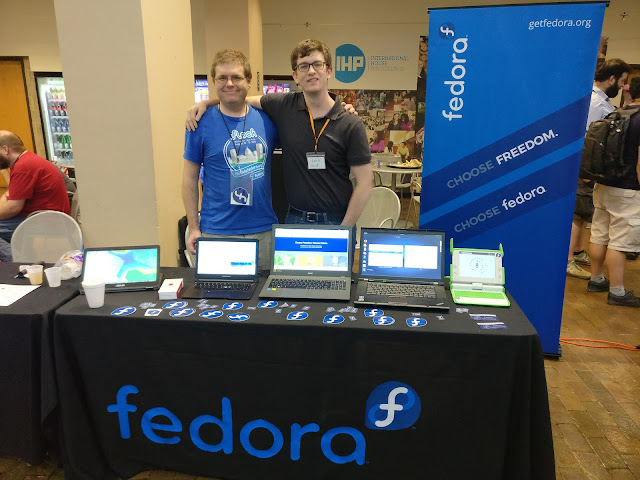The event went very well. Over half of all people who came to the table were enrolled in computer science (or a similar major) and have used linux anywhere from a little bit to a lot. A huge majority were using Python in their curriculum.The fact that Fedora workstation is focused on software developers was a huge selling point. Some of the things shown off were:
- GNOME Terminal's features added over the last 4 years (since developers a large portion of their time in the terminal.) Specifically, reflow support, and notifications for long-running commands completing (for example, build commands.)
- GNOME Builder as an IDE for graphical (Python) development.
- Python 3.6 in Fedora 26.
- The page listing all the features in Fedora Python Classroom (lab.)
- The Python page on the Fedora developer portal.
- How easy it is to install a complete web application stack, like Python + Flask + MySQL, with a single dnf command.
Some other highlights of the event were:
- Sanqui provided a Fedorator. It was a great conversation starter, and a few people flashed Fedora onto their USB key via it.
- Flatpak was a great to show off. I would browse to http://flatpak.org/apps.html , download a ~5KB .flatpakref file, and open it in GNOME Software. Users would then see the description, screenshots, and metadata. This is the perfect example of how an awesome new technology is integrated into both Fedora (and GNOME,) and a way to differentiate Fedora from other distros.
- WRT the last point, the captain of George Tech's Counter-Strike (Global Offensive) eSports team stopped by. He was delighted to see both GNOME Twitch and Discord available via Flatpaks. (Twitch and Discord are essential services for eSports.)
- GNOME Software was a great demonstration of how Fedora is easy to use.
- Several people run Linux servers already. We installed Cockpit on the demo laptop and showed it off. The fact that it is installed by default on Fedora server enables us to say that Fedora server is easier to use than other server distros.
- 2 people needed help using other Linux distros, and I was able to help them successfully.
- Several people either are using Fedora or have used it, and they liked it.
- The OLPC continues to be a great conversation starter.
- The Motorola Lapdock + Raspberry Pi also drew the interest of a few people. However, it ran into a couple of instances where either it froze up, or the usb data connection (to the keyboard & trackpad) was lost. I chose not to leave it in the event box due to these issues; discussion with other ambassadors about this is ongoing.
There were also 2 Fedora use cases that students mentioned, which were particularly noteworthy:
- One student said he is interning at a Biotech company where he deploys a production application on Fedora server. The application is a in-house-written ERP system.
- Another student said he is doing computational biology on Fedora systems. They use GPUs to accelerate it. They compared multiple Linux distros, and chose Fedora because it is all around the best for their work.
Also, I do want to point something out that we did differently. Instead of putting the multi-iso on the event box's laptop's hard disk, we put Fedora Workstation on it. We then loaded it up with numerous development tools. For example, we installed builder, created a demo project, and then the demo project pulled in the GNOME runtime. All this software would have exhausted the RAM disk used by the ISO.




